2017 Ducati Multistrada Enduro tweaked
Vehicle Hold Control added to Multistrada Enduro for 2017, with further off-road riding improvements
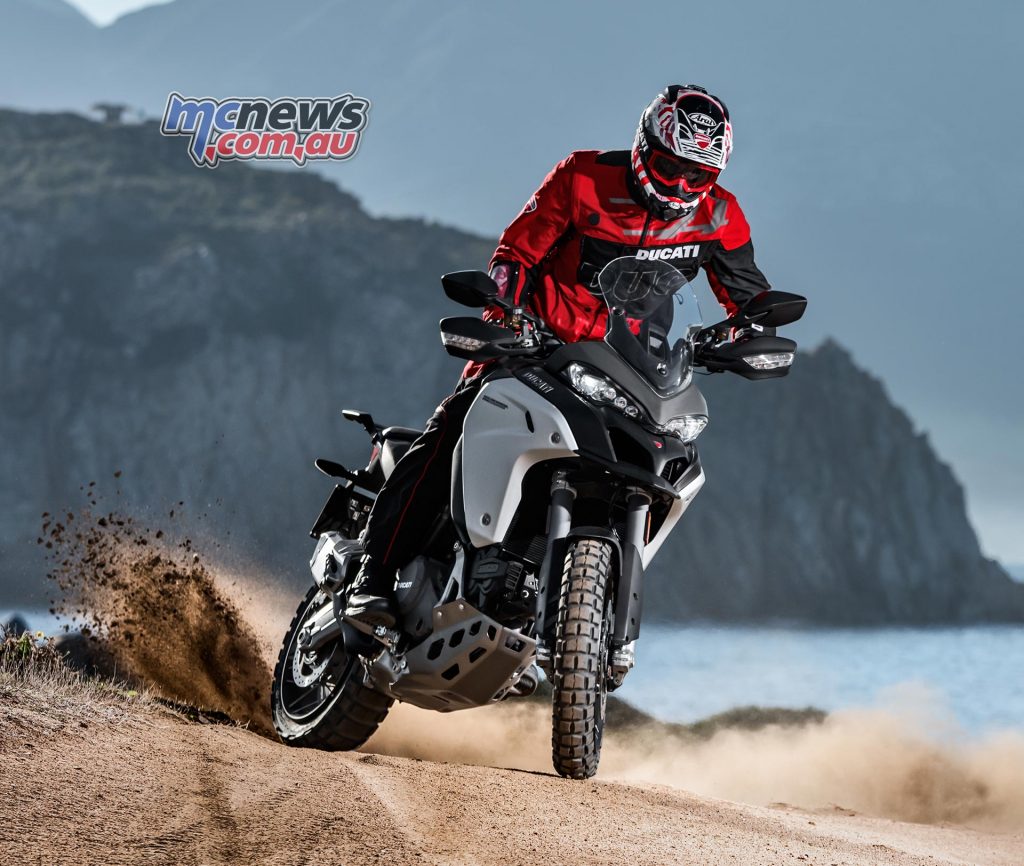
The Multistrada 1200 Enduro completes the multi-bike concept introduced by Ducati in 2010, with this maxi-enduro specifically developed and built to handle the stress and strain of off-road riding.
Thanks to spoked wheels – 19in at the front and 17in at the rear – the Multistrada 1200 Enduro is ideal for long-distance adventures. Featuring electronic semi-active Sachs suspension (front and rear) and a 30-litre fuel tank, the Multistrada 1200 Enduro has a range that can exceed 450 kilometres (280 miles).
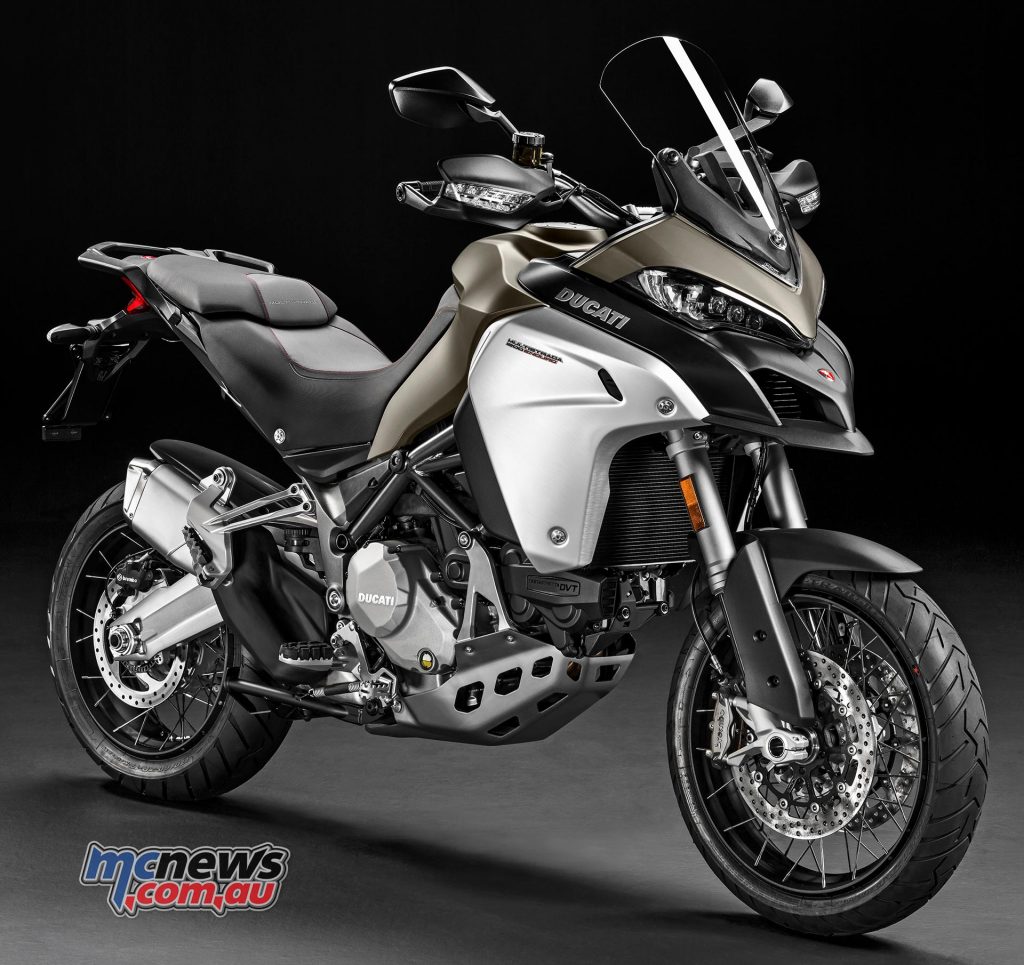
The electronics package is top notch, thanks to the Inertial Measurement Unit (IMU), developed by Bosch, which dynamically measures pitch and roll angles and acceleration along the 3 axes, raising performance and safety standards even further.
On the Multistrada 1200 Enduro Cornering ABS, Cornering Lights (DCL), Ducati Traction Control (DTC), Ducati Wheelie Control (DWC) and the semi-active Ducati Skyhook Suspension (DSS) Evolution system with 200mm of wheel travel all come as standard. And for the very first time on a Ducati, Vehicle Hold Control (VHC) has been introduced to aid uphill starts.
Tested and developed under the most extreme conditions, the Multistrada 1200 Enduro features the excellent, hard-wearing Multistrada 1200 frame together with a new twin-sided swingarm.
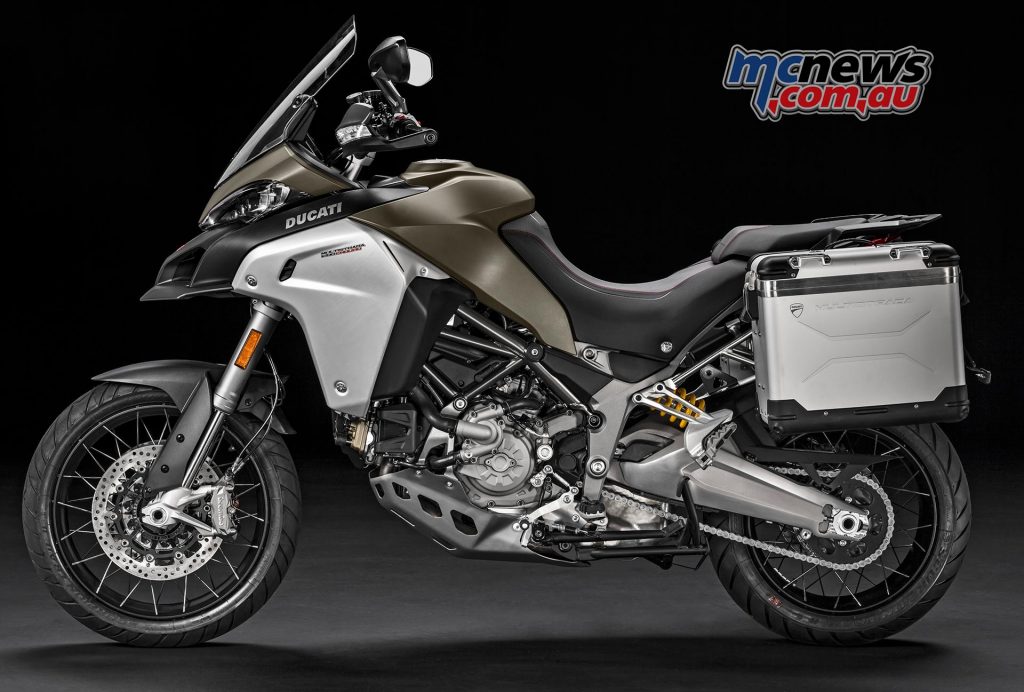
The bike is powered by the tried and tested 160 hp Ducati Testastretta DVT (Desmodromic Variable Timing) engine with EURO 4 type approval, now equipped with a new exhaust system.
Thanks to Riding Mode technology (Enduro, Touring, Sport and Urban), the Multistrada 1200 Enduro offers that same four-bikes-in-one spirit that has made the Ducati multibike such a winner.
Other as-standard features on the Multistrada 1200 Enduro include electronic speed control and the Bluetooth module; the latter, via the Ducati Multimedia System (DMS), lets riders connect the bike to a smartphone and manage key multimedia functions (incoming calls, text messaging, music) via the switchgear and display information on the TFT dashboard.
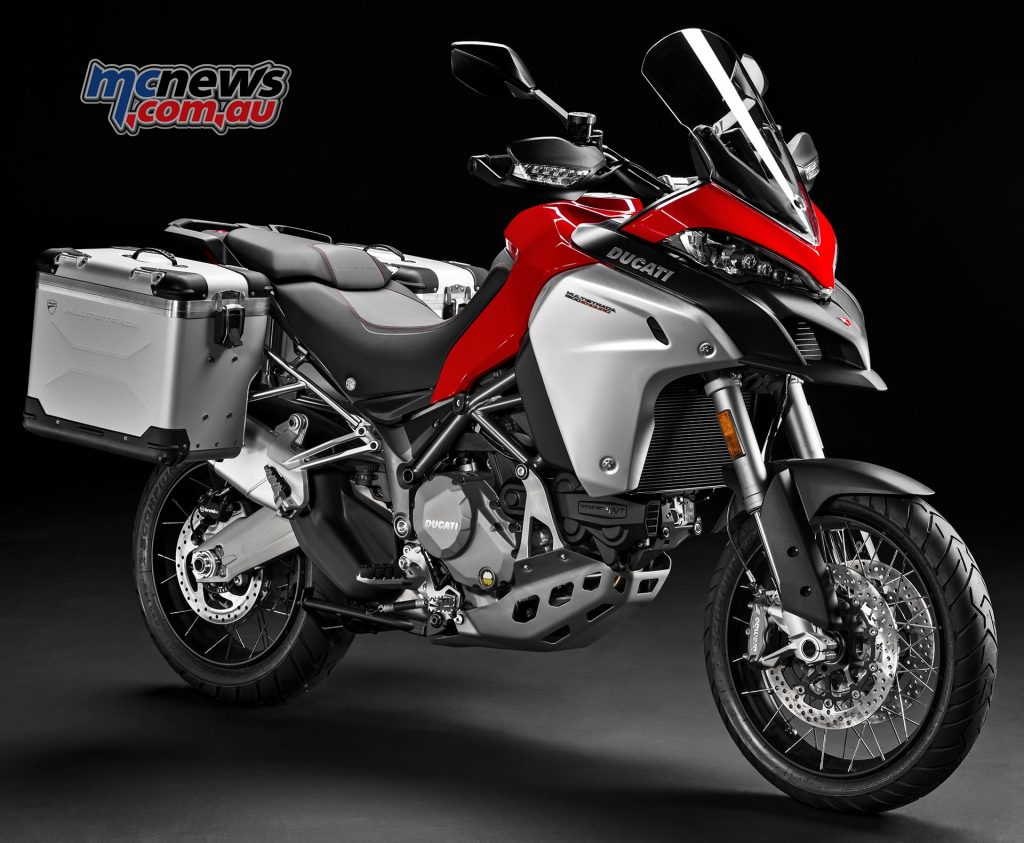
Thanks to the standard Bluetooth connection on the Multistrada Enduro, the new Multistrada Link App, available for iOS and soon also for Android, allows to connect your smartphone and record data of the bike and road itineraries. Data such as speed, lean angle, power and consumption can be displayed directly on the map and riding diary, allowing you to relive all your riding emotions, turn after turn.
The Multistrada 1200 Enduro comes in three different colours (Ducati Red, Phantom Grey and Star White Silk) and can be personalised with items from the comprehensive Ducati Performance accessory catalogue by Touratech which includes the four Enduro, Touring, Sport and Urban packages.
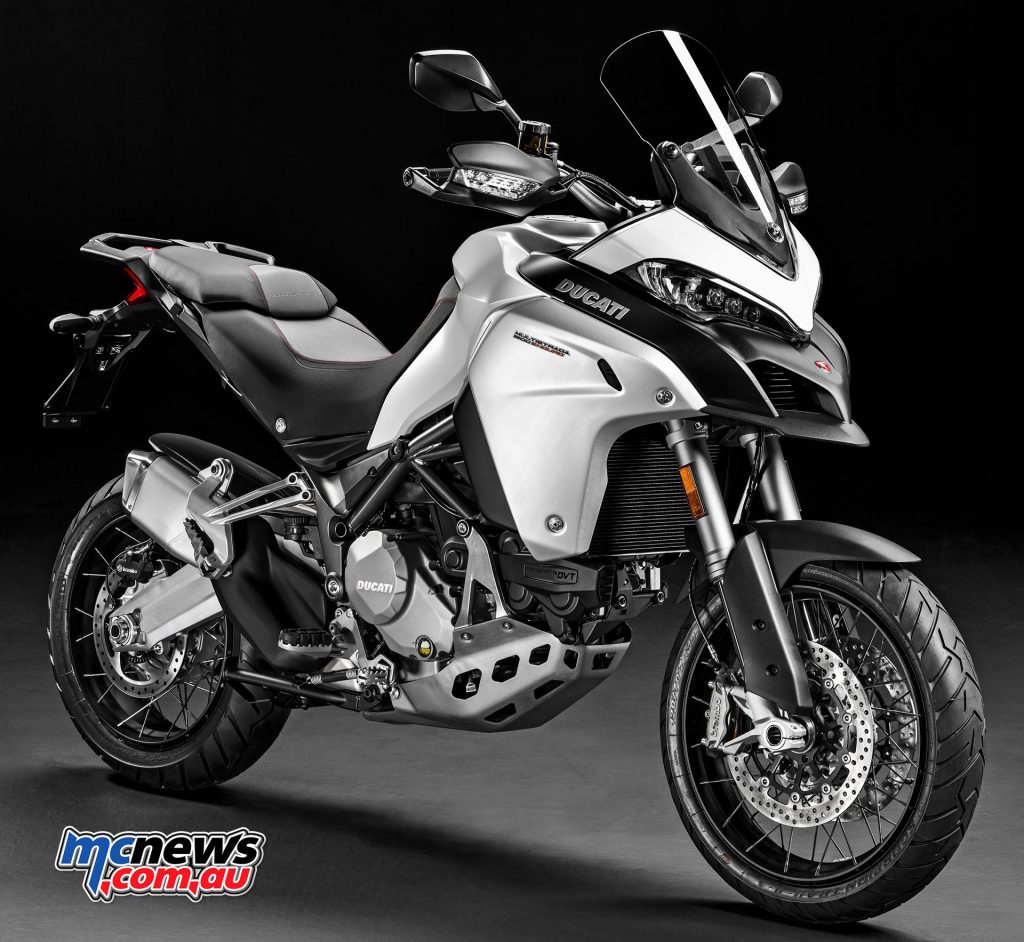
2017 Multistrada 1200 Enduro main features
- Colours – Ducati Red, Phantom Grey, Star White Silk
- Ducati Testastretta DVT engine
- Inertial Measurement Unit (IMU) by Bosch
- Bosch-Brembo ABS 9.1ME Cornering braking system
- Electronic cruise control
- Riding Modes
- Ducati Multimedia System (DMS)
- Ride-by-Wire Power Modes (PM)
- Ducati Wheelie Control (DWC)
- Ducati Traction Control (DTC)
- Vehicle Hold Control (VHC)
- Sachs semi-active electronic suspension (front and rear): Ducati Skyhook Suspension (DSS) Evolution system
- Sachs steering damper
- Full LED headlight with Ducati Cornering Lights (DCL)
- Dashboard with full-TFT 5” colour screen
- Centre stand
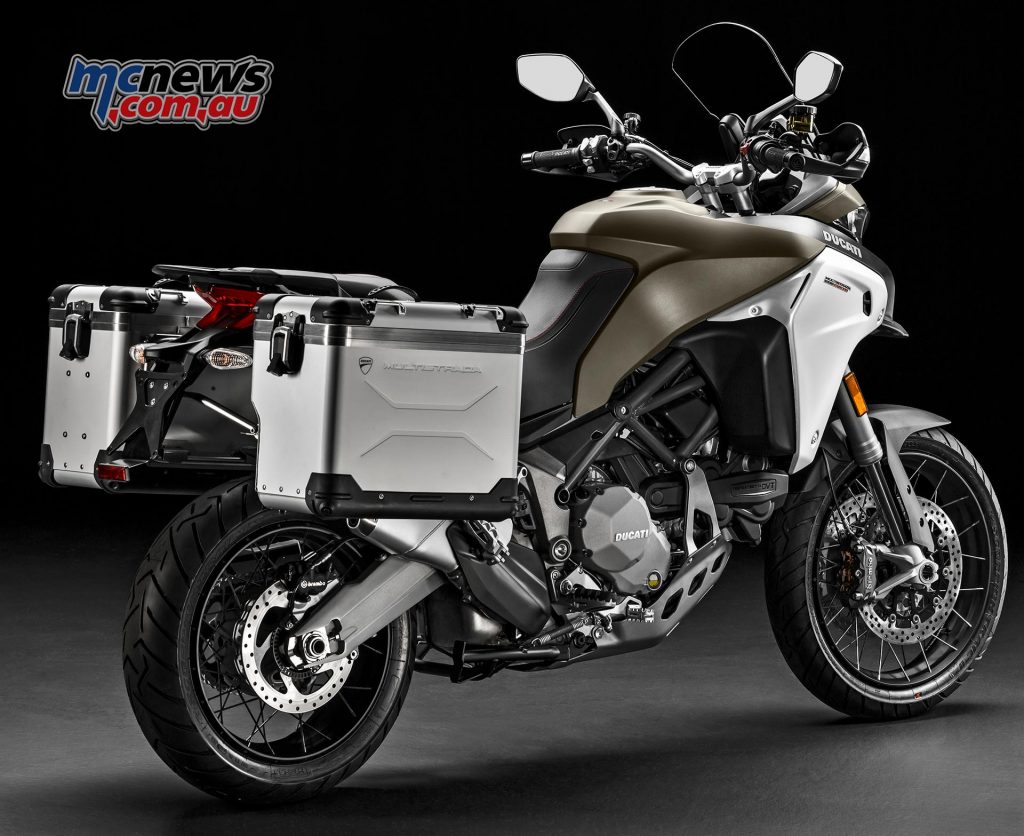
Personalisation packages
- Touring Pack: heated grips, Ducati Performance by Touratech aluminium panniers and handlebar bag
- Sport Pack: type-approved Ducati Performance by Termignoni exhaust (complies with EU homologation requisites), billet black aluminium water pump cover, billet aluminium front brake fluid and clutch fluid reservoir caps
- Urban Pack: Ducati Performance by Touratech aluminium top case , tank bag with tank lock and USB hub to charge electronic devices
- Enduro Pack: Supplementary LED lights, Ducati Performance by Touratech components: crash bars, radiator protection, oil radiator protection, chain guide, rear brake guard.
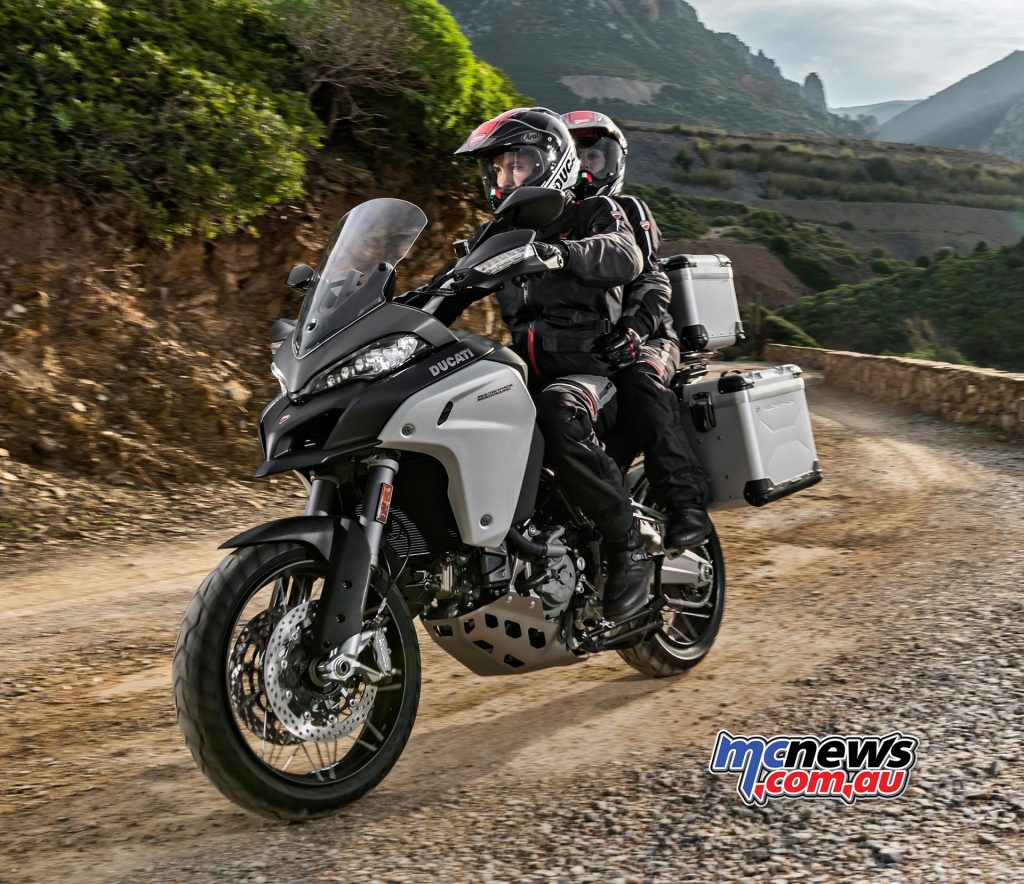
Design and ergonomics
At the front end, a thorough overhaul has allowed incorporation of a new 30-litre tank. The front beak is now longer and the two tank side covers are made of anodised aluminium for a sturdier assembly. The front mudguard has been redesigned and repositioned to ensure better protection against mud.
The light front-end lines blends with the streamlined tail section, redesigned for optimal control while riding standing on the foot pegs. The seats have been redesigned as well to ensure easier rider movements during off-road riding.
The riding position of the Multistrada 1200 Enduro has been designed to ensure improved off-road handling. The handlebars are higher and the seat is narrower in the crotch area, the footpegs are made of microcast steel and have removable rubber inserts.
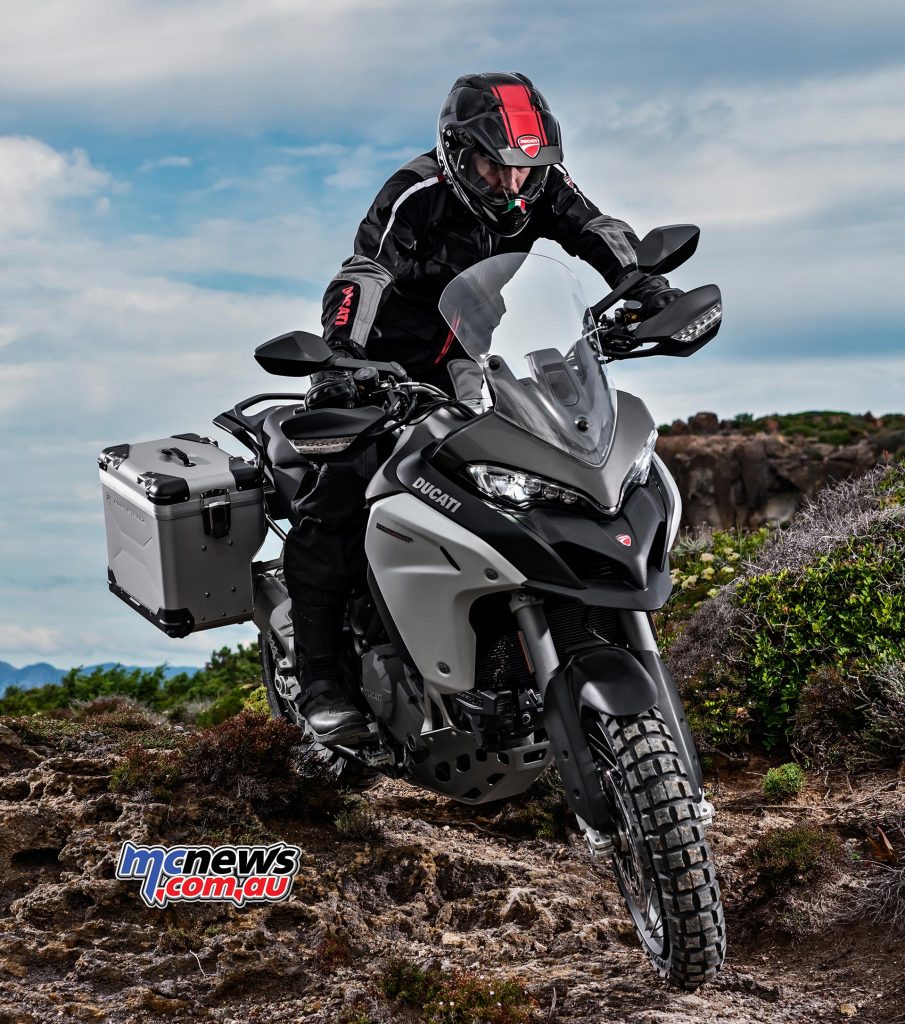
Like the footpegs, lever design also takes its cue from the off-road world: the rear brake lever can easily be height-adjusted to two different positions while the gear lever has an articulated coupling to prevent breakage in the event of a fall or contact with an obstacle.
To shield the twin-cylinder engine, the Multistrada 1200 Enduro mounts an aluminium sump guard with supports connected directly to the chassis.
The Multistrada 1200 Enduro is equipped as standard with an 870mm high seat, while a higher 890mm version – more comfortable yet still suited to off-road riding – and a lower 850mm one, for riders of any build to rest their feet firmly on the ground, are available as accessories.
A narrower, lower passenger seat is also available as an accessory, allowing the rider to freely shift his weight backwards while standing on the footpegs.
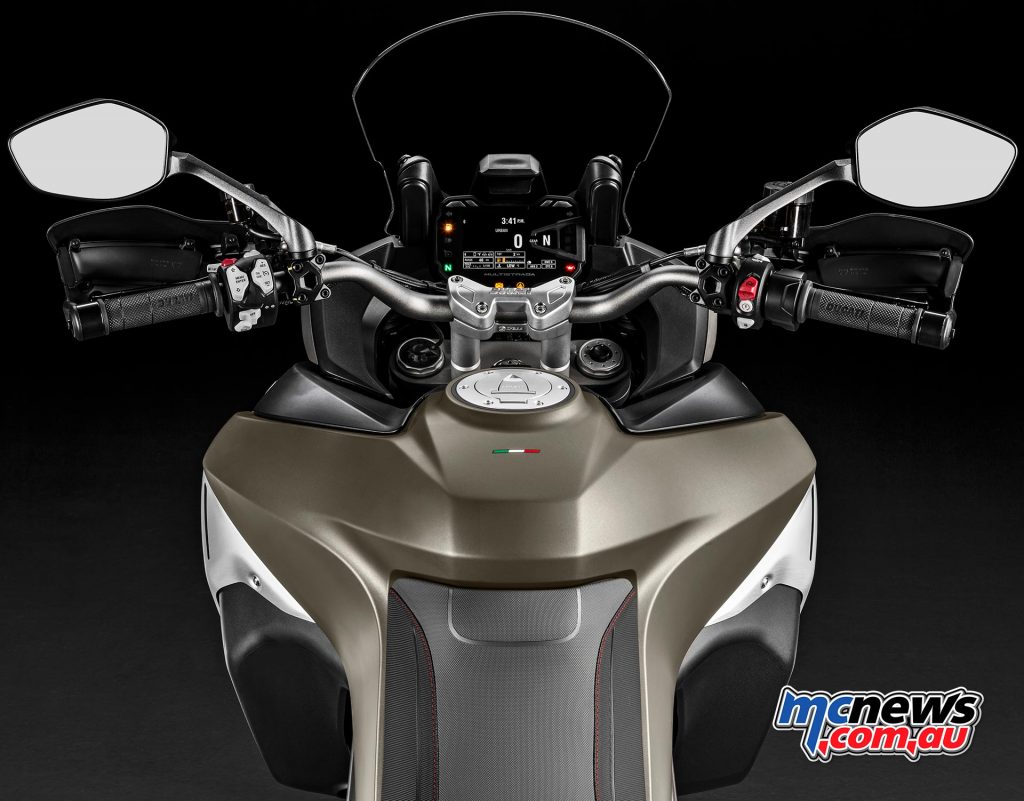
The screen on the new Multistrada 1200 Enduro offers 60mm of vertical travel and can be adjusted using just one hand, and for off-road riding enthusiasts, the accessory line includes a lower Plexiglas screen.
Two 12-volt power outlets are available, one in the area immediately below the passenger seat and the other in the front dashboard area. These can handle loads of up to 8A (fused) to power accessories such as thermal apparel, intercoms or mobile phone chargers. The Garmin sat-nav, available as a Ducati Performance accessory, is powered off a special connector also located in the dashboard area. A USB slot for mobile phone charging is located in the area below the seat.
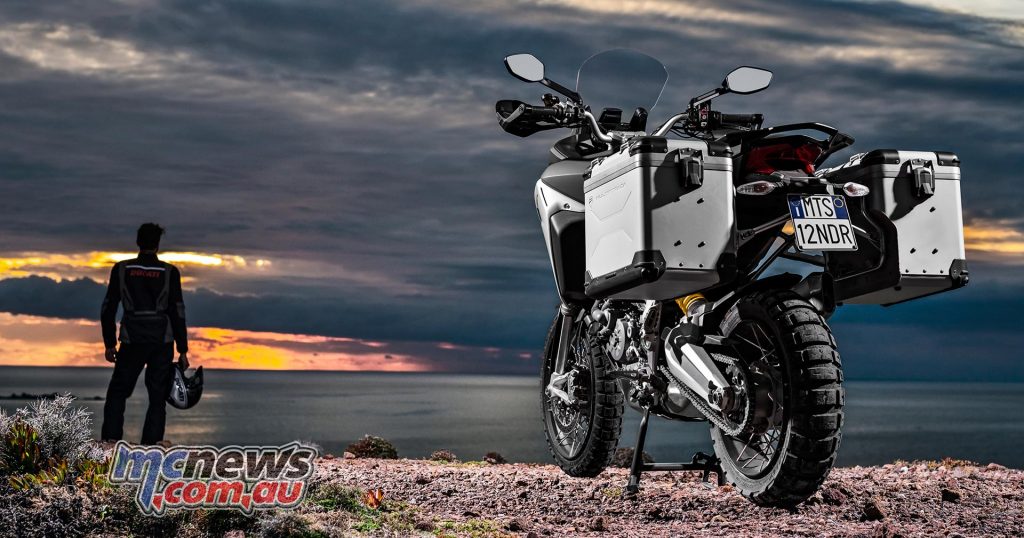
The Multistrada 1200 Enduro features a centre stand as standard.
The stowage area under the passenger seat is ideal for a toolkit, user and maintenance manual or other personal items. To ensure that the Multistrada can also be efficiently used as a long-distance tourer there are plenty of other optional items such as the generously sized, smart-looking Ducati Performance by Touratech aluminium panniers.
The rear grab handle has been specially redesigned in order to minimise the overall width of the bike even when the panniers are fitted.
Other touring accessories include heated grips, essential for travelling in adverse weather.
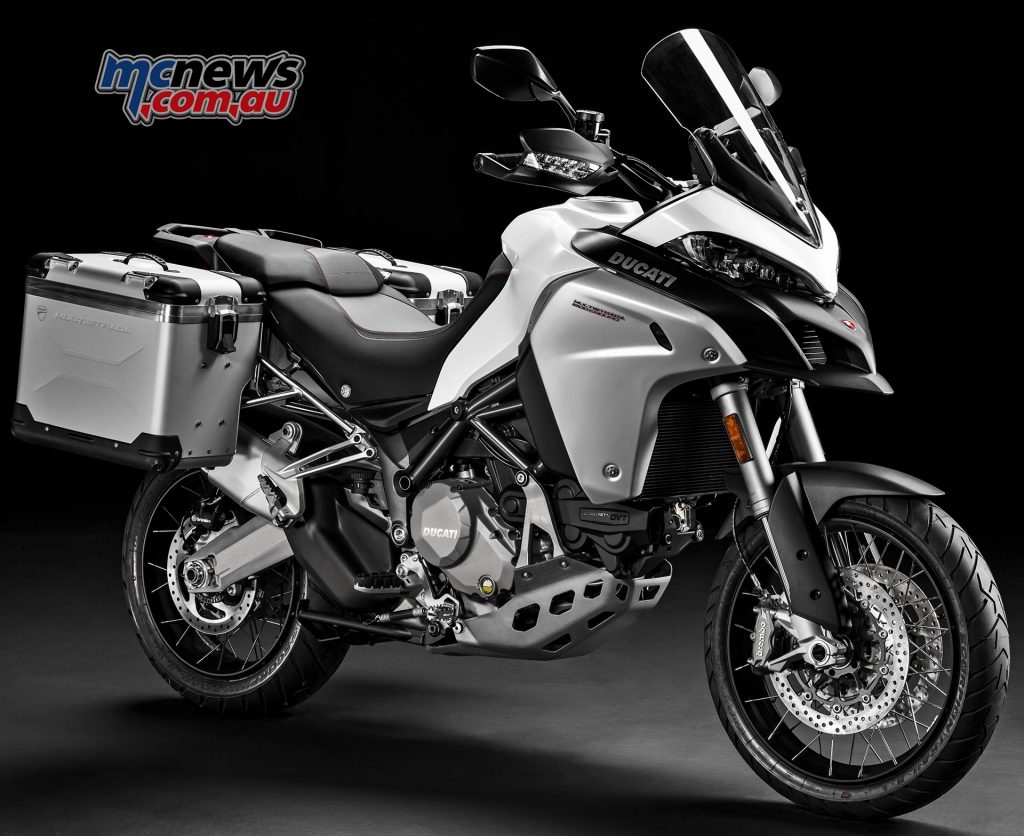
Ducati Testastretta DVT
By independently varying the timing of the camshaft that controls the intake valves and the camshaft that controls the exhaust valves, the DVT engine optimises high-rpm performance to provide maximum power.
At low-to-medium rpm, instead, it smooths operation, making power delivery more fluid and boosting torque. In practice, this is an engine that changes its characteristics as rpm varies while complying with Euro 4 specifications and ensuring good fuel economy.
Variance of the valve overlap angle has been achieved by adopting the DVT (Desmodromic Variable Timing) system: a valve timing adjuster applied on the ends of each of the two overhead camshafts.
The DVT system is divided into two parts: an external housing rigidly connected to the pulley driven by the timing belt and an internal mechanism connected to the camshaft: the latter is coaxial to the former and can rotate in advance or delay with respect to the housing depending on the oil pressure in special chambers.
This oil pressure is adjusted by dedicated valves and the timing of each cam is controlled dynamically by a sensor in the cam covers.
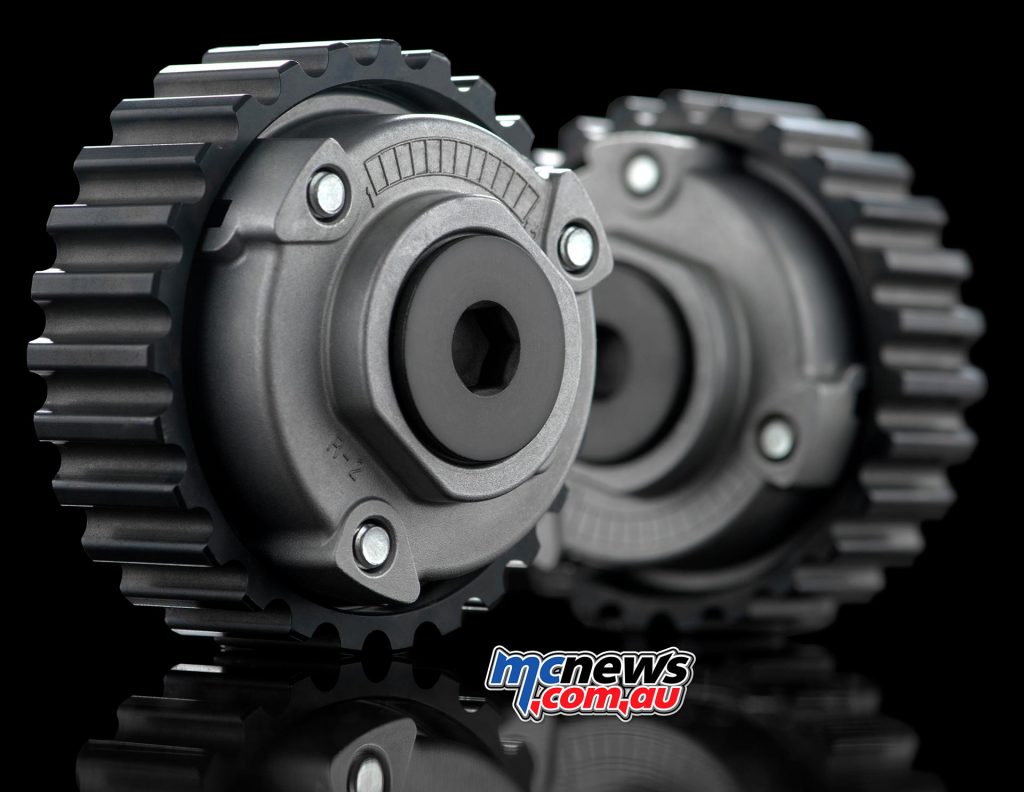
As might be expected, the Ducati Testastretta DVT engine uses the Desmodromic valve actuation system that has made the Bologna-built bikes famous worldwide. This special system closes the intake and exhaust valves mechanically, with the same precision as they are opened.
The design of the Ducati Testastretta DVT engine shows how Desmodromic valve actuation provides a clear advantage over traditional valve springs; at low revs the system requires less force because there are no springs to be compressed. This makes it possible to keep the individual valve timing adjusters compact, which minimizes their weight and allows them to be smoothly integrated.
As a result, with a bore of 106mm and stroke of 67.9mm, giving a total displacement of 1198cc, the Ducati Testastretta DVT delivers 160hp at 9500rpm and 136Nm of torque at 7500rpm. Even at just 3500rpm the available torque is already 100Nm and remains near-constant, exceeding 110Nm between 5000 and 10,000rpm.
Ducati’s continuous research and development into injection systems has led, on the Ducati Testastretta DVT, to the use of fuel injectors positioned to direct their spray onto the heated rear of the intake valve instead of the relatively cooler intake duct wall. This maximises fuel vaporisation, improving combustion and smoothness.
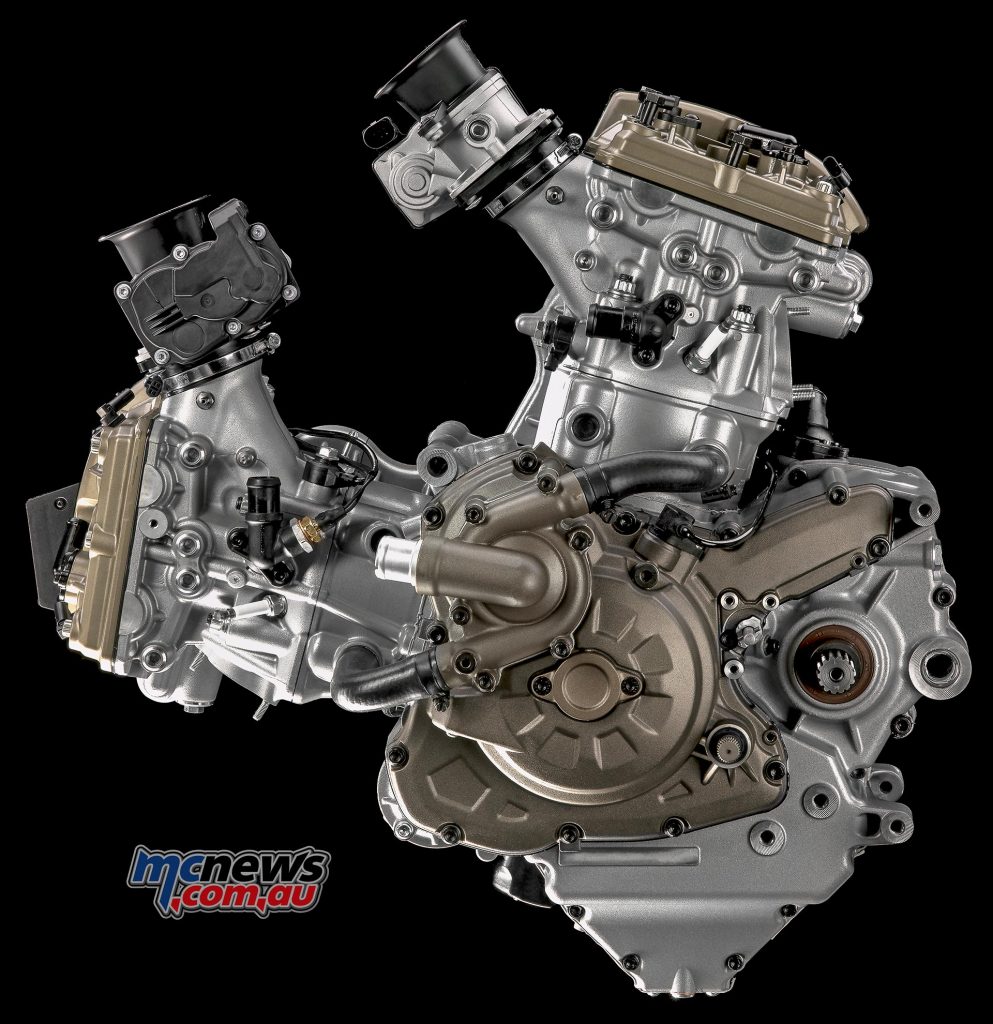
The DVT is also equipped with the Dual Spark (DS) system, which uses two spark plugs per cylinder to enhance combustion efficiency in all circumstances. Each spark plug has independent ignition control to ensure optimisation throughout the rev range under all riding conditions.
There is also an anti-knock sensor to keep the engine running smoothly even when lower-octane fuels are used or under other conditions (e.g. high altitude) that might affect combustion, and can be important during longer journeys and in remote regions.
Lastly, to maximize performance and minimize emissions, the Ducati Testastretta DVT also features a secondary air system. This allows a richer fuel mixture to be used without increasing emissions, by completely oxidizing unburnt hydrocarbons to keep HC and CO levels to a minimum.
The Multistrada 1200 Enduro mounts a six-speed gearbox on which the first gear ratio is shorter than that on the other bikes in the Multistrada family in order to improve off-road performance and ensure better handling on more technical, low-speed tracts. The clutch on the Multistrada 1200 Enduro is of the oil-bath slipper type.
The exhaust system layout is based on two primary manifolds that merge directly in the single 2-chamber silencer; the latter, in addition to acting as a 2-1-2 collector, contains the catalytic converter. From here two pipes exit directly towards the light, compact silencers, which are side-mounted in a high position and feature aluminium alloy outer sleeves.
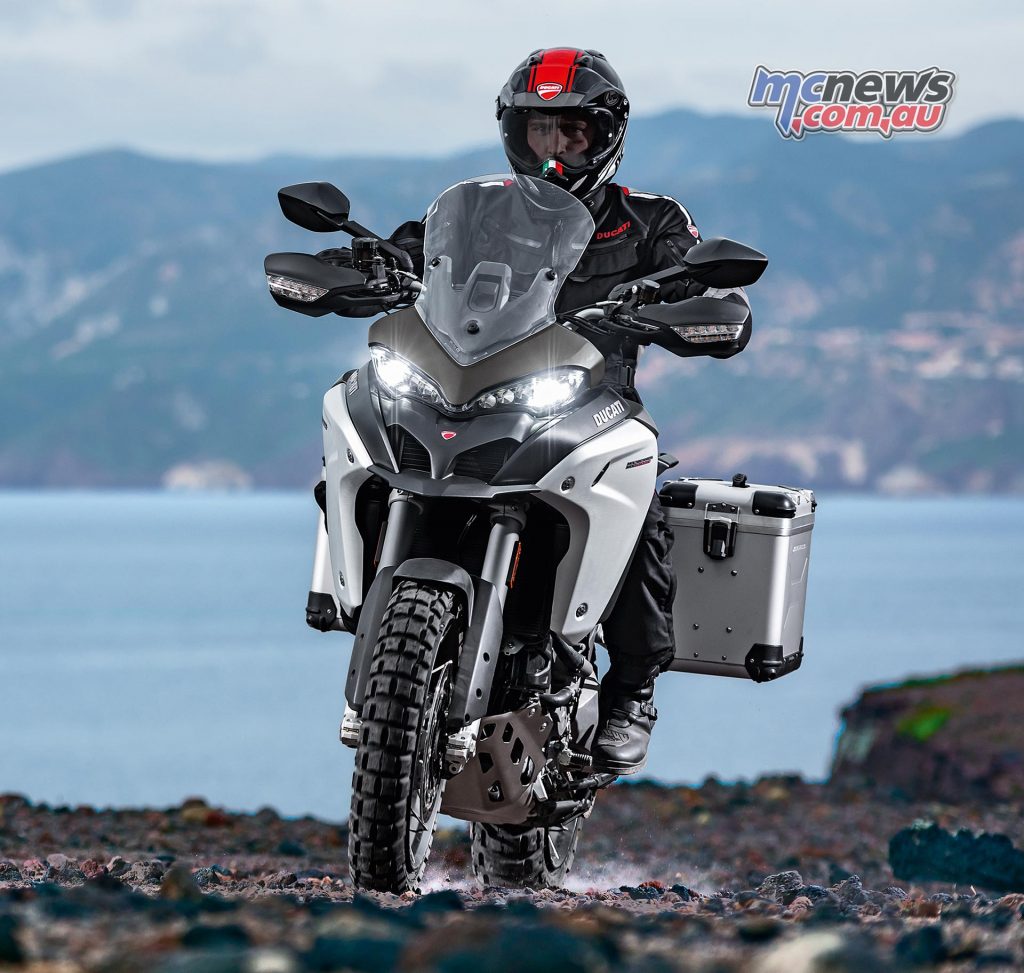
Long maintenance intervals
Ensured by design, advanced materials and cutting-edge engineering – has allowed Ducati to reduce scheduled maintenance requirements; routine maintenance intervals have been extended to 15,000 km 18,000 miles) (or one year) and valve timing adjustment to 30,000 km (9,000 miles), providing clear advantages for customers.
This has been achieved by employing special materials for the valve seats, improving combustion efficiency, and containing the running temperature of the Ducati Testastretta DVT engine. Moreover, the innovative DVT system does not in any way complicate the valve timing adjustment procedure.
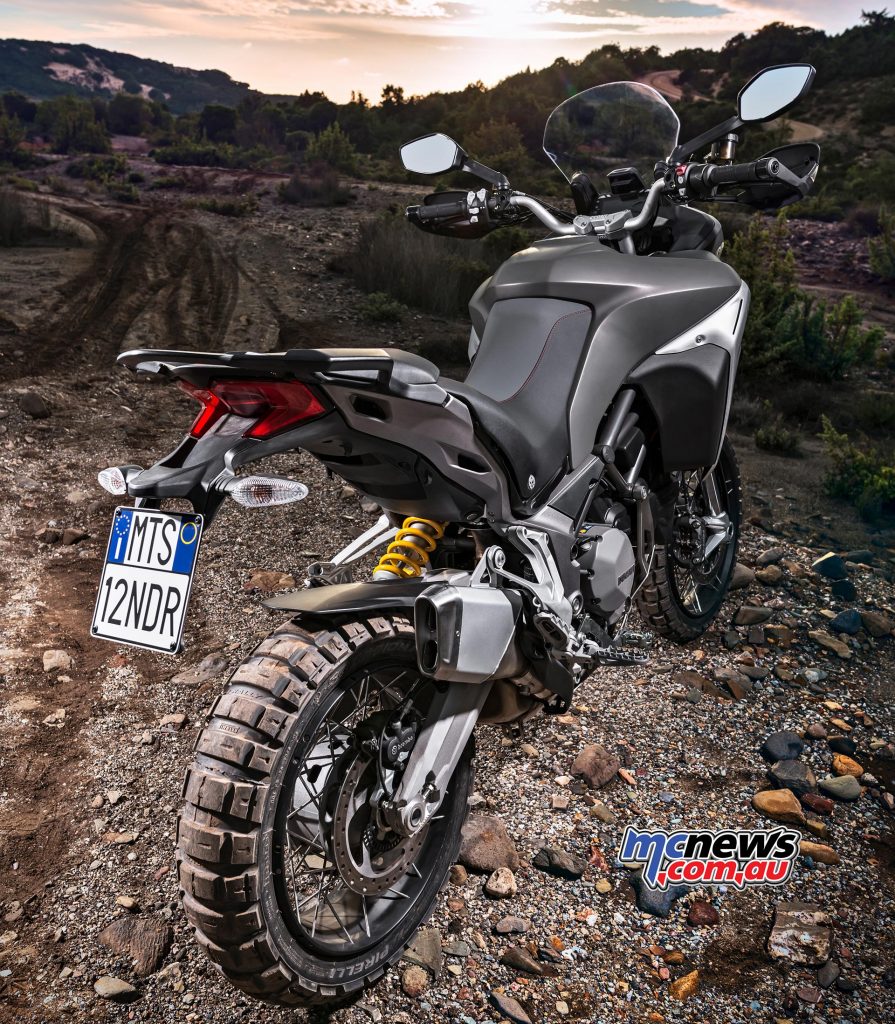
Innovative technology
Thanks to the Bosch IMU (Inertial Measurement Unit) the four Riding Modes (Enduro, Touring, Sport and Urban) have a new feel on the Multistrada 1200 Enduro.
Each Riding Mode features different Ducati Skyhook Suspension (DSS) Evolution system settings – the DSS configures the suspension set-up almost instantaneously thanks to input from on-vehicle sensors, ensuring the vehicle body is insulated against road unevenness to provide enhanced comfort in Enduro, Touring and Urban modes.
In Sport Riding Mode, instead, the suspension is set to ensure the best on-wheel load, indispensable for racier riding. Moreover, each Riding Mode is associated with different Ducati Wheelie Control (DWC), Ducati Traction Control (DTC) and Cornering ABS settings.
All electronic control systems can be adjusted to intervene as desired while the Default function allows all values (or just those required) to be returned to their standard settings.
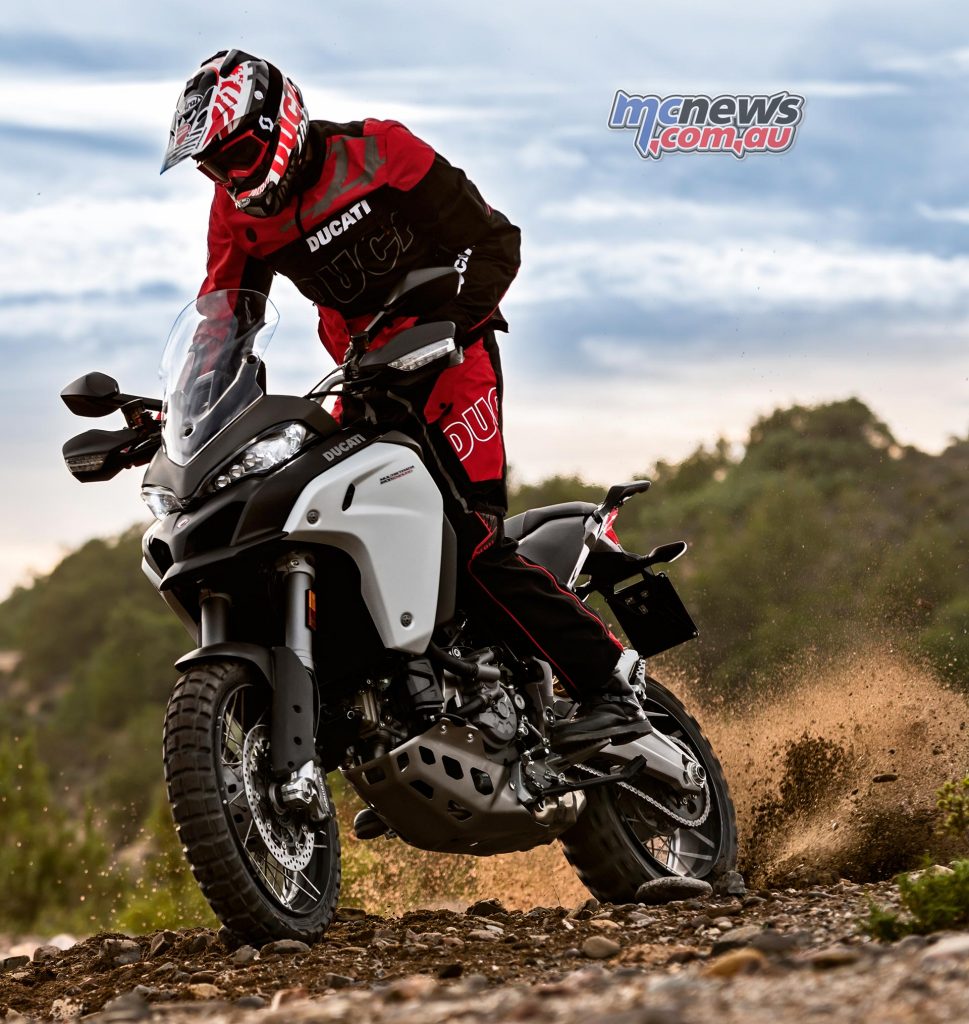
On the Multistrada 1200 Enduro, engine power is delivered through a Ride By Wire system. Torque is no longer adjusted directly by a throttle cable but electronically: a signal is read and processed by the engine control unit which then modulates throttle body aperture. The Ride by Wire system allows three different engine power mappings to be used.
- Enduro Riding Mode – With the Enduro Riding Mode the off-road character of the Multistrada 1200 comes to the fore: engine power is set to 100 hp and DSS Evolution intervention is reconfigured for rough terrain riding. DTC system settings ensure maximum off-road grip and acceleration, while the DWC is disengaged. The ABS, instead, is set to Level 1, the most suitable for low-grip surfaces: at this intervention level rear wheel lift detection is deactivated, as are the cornering and ABS functions on the rear wheel so that it can be locked.
- Touring Riding Mode – In Touring Riding Mode maximum power is 160 hp but delivery is smooth and progressive. Active safety is enhanced by higher DTC and DWC intervention levels. The ABS is set to interaction Level 3, perfect for touring, allowing for supremely confident riding thanks to rear wheel lift prevention, optimisation of combined braking and the active cornering function. The DSS Evolution is programmed to provide a suspension set-up suited to long rides, maximising comfort for both rider and passenger.
- Sport Riding Mode – Selecting Sport Riding Mode transforms the Multistrada 1200 Enduro into a high-adrenalin 160 hp machine with a torque of 136 Nm and a sport-style suspension set up. This Riding Mode is also characterised by reduced DTC and DWC intervention. With ABS set to Level 2, rear wheel lift detection is disengaged but the cornering function remains on, perfect for riders who want to push it to the max.
- Urban Riding Mode – Selecting Urban Riding Mode reduces the power to 100 hp and applies suspension settings that let the rider overcome frequently encountered urban obstacles such as bumps and manhole covers with ease. DTC and DWC settings are high while the ABS is set to the so-called “Safe & Stable” Level 3. This setting allows for supremely confident riding thanks to rear wheel lift prevention, optimisation of combined braking and the active cornering function.
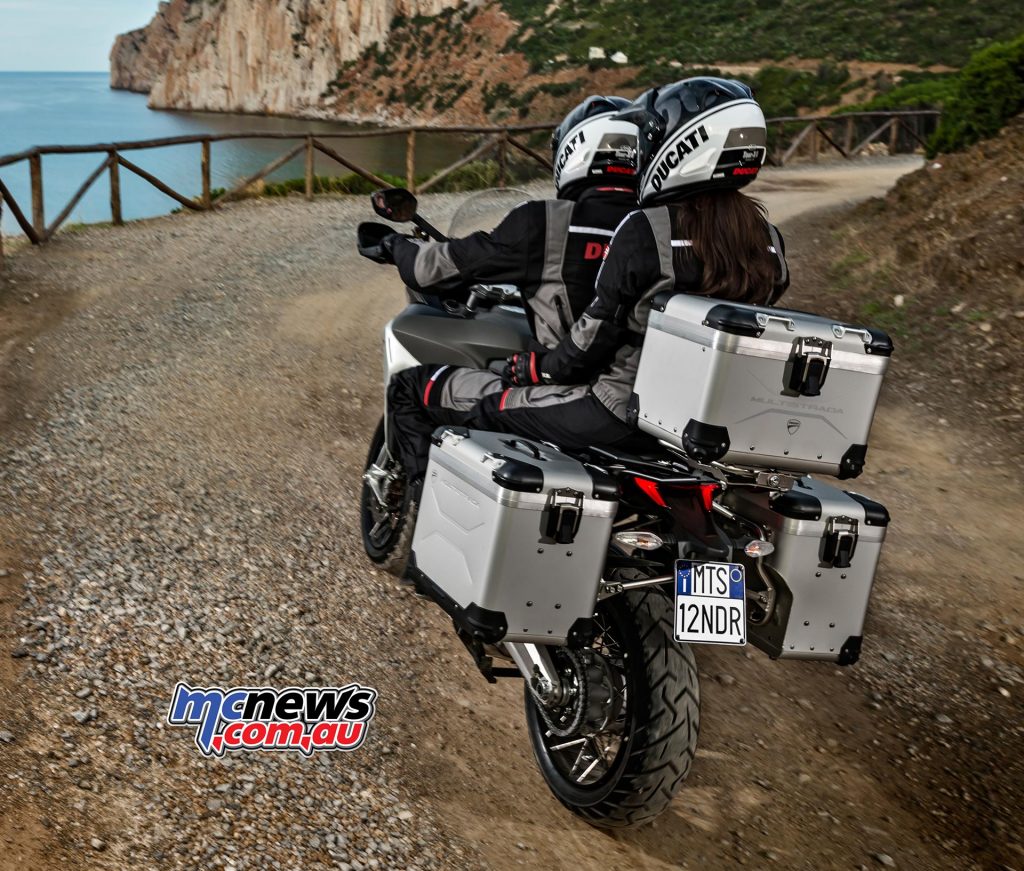
DTC (Ducati Traction Control)
Ducati Traction Control is a competition-derived system that acts as a filter between the rider’s right hand and the rear tyre. Within the space of just a few milliseconds the DTC can detect and, subsequently, control any wheelspin, improving bike performance and active safety considerably.
This system has eight different intervention levels. Each one has been programmed to provide a rear wheelspin tolerance that matches progressive levels of riding ability (classified from one to eight). Levels 1 and 2 are specifically intended for off-road conditions, providing ideal rear wheelspin control settings. Levels from 3 to 6 ensure excellent grip on dry asphalt while levels 7 and 8 are designed to maximise grip on wet tarmac.
On the Multistrada 1200, DTC is incorporated into the Riding Modes. DTC levels within the four modes are initially pre-set but can subsequently be personalised and saved to suit individual riding styles or preferences.
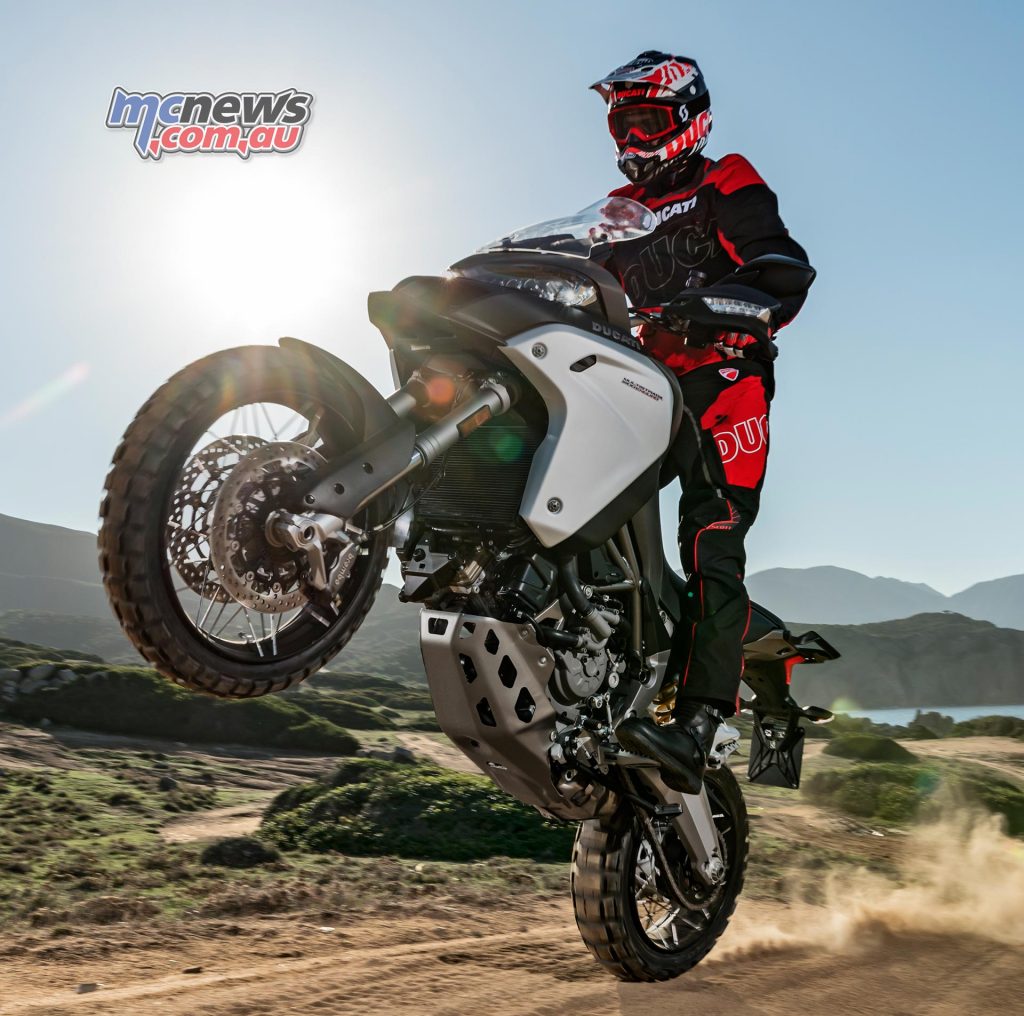
Ducati Wheelie Control (DWC)
This system analyses the attitude of the bike (to detect any front wheel lift) and controls torque and power accordingly to maximise acceleration in safety without destabilising balance. Like DTC, it features 8-level adjustment and is incorporated into the Riding Modes.
Ducati Skyhook Suspension (DSS) Evolution
The DSS (Ducati Skyhook Suspension) Evolution system on the Multistrada 1200 Enduro is based on a 48mm fork and a Sachs rear shock. These ensure 200mm of wheel travel both front and back. Electronic suspension allows for continuous rebound and compression damping adjustment, with semi-active control giving optimal vehicle balance.
DSS Evolution technology analyses data from numerous sensors on the sprung and unsprung weights of the vehicle to calculate and set the damping needed to make the ride as smooth as possible.
An accelerometer on the steering yoke, one at the rear of the bike and one inside the control unit that tracks the DSS Evolution provide data on sprung weight while an accelerometer on the fork bottom provides input on unsprung weight.
At the rear, another sensor measures suspension travel. The DSS Evolution processes this information via a semi-active control algorithm that, by referring to an imaginary fixed point in the sky above the bike, makes extremely rapid adjustments to the hydraulic damper to minimise vehicle movement in relation to this point: just as if the bike were suspended from it (hence the term “skyhook”).
To smooth the effect of the longitudinal forces of acceleration and deceleration, the system also makes use of the Ducati Traction Control (DTC) longitudinal accelerometer sensor, the ABS system pressure detectors for rapid calculation and activation of a response that reduces resulting vehicle oscillation, and the data from the Bosch IMU which dynamically reveals the bike’s attitude on the two axes (lateral and vertical tilt).
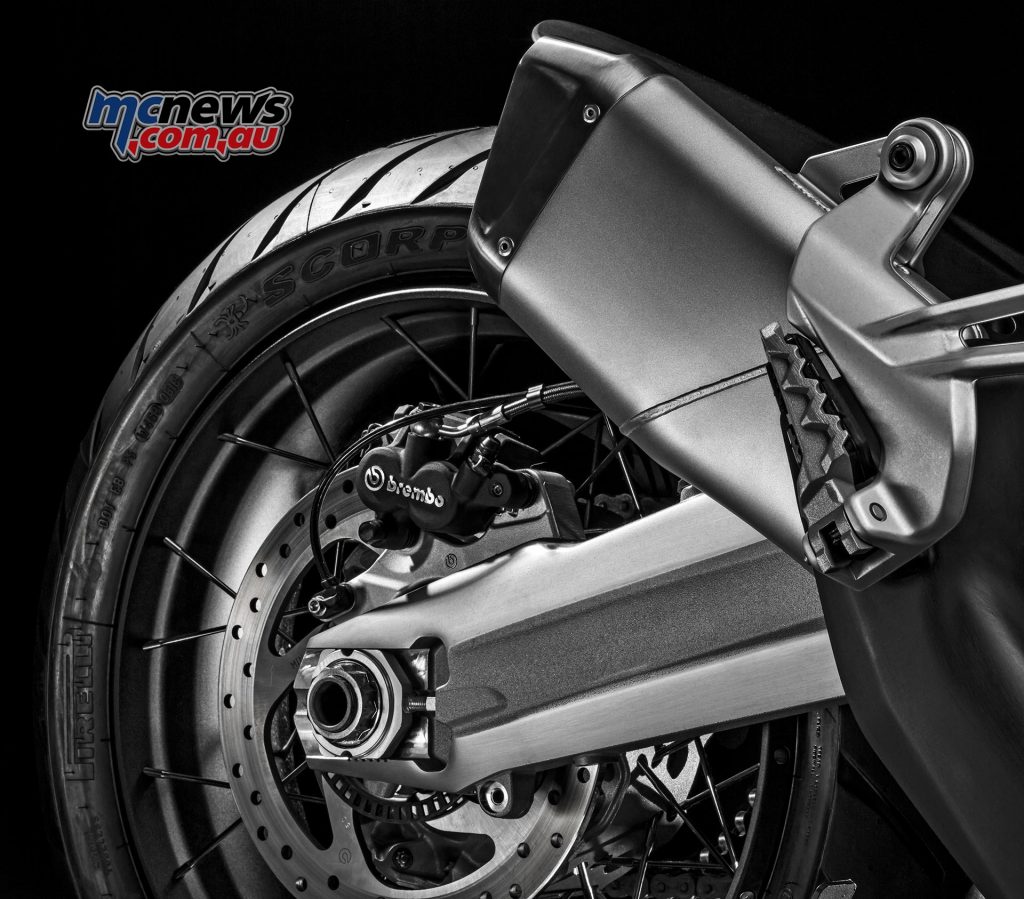
Brembo brake system with Bosch Cornering ABS
The Multistrada 1200 Enduro features a Brembo braking system with the Bosch 9.1ME ABS ECU, an integral part of the Ducati Safety Pack (DSP). Cornering ABS makes use of the Bosch IMU (Inertial Measurement Unit) platform to optimise front and rear braking power even in critical situations with the bike at considerable lean angles.
Through interaction with the Riding Modes, the system provides compromise-free solutions whatever the situation or riding conditions.
Thanks to its ABS control processor the Multistrada makes use of an Electronic Combined Braking System that is optimised for the Urban and Touring Riding Modes, but has a lower degree of interaction in Sport mode where combined braking is less desirable. The combined braking system increases stability by using four pressure detectors to allocate braking power optimally between front and rear.
Designed to improve rear tyre control during hard braking, the rear wheel lift detection is fully enabled in Urban and Touring Riding Modes yet disabled in Sport and Enduro modes.
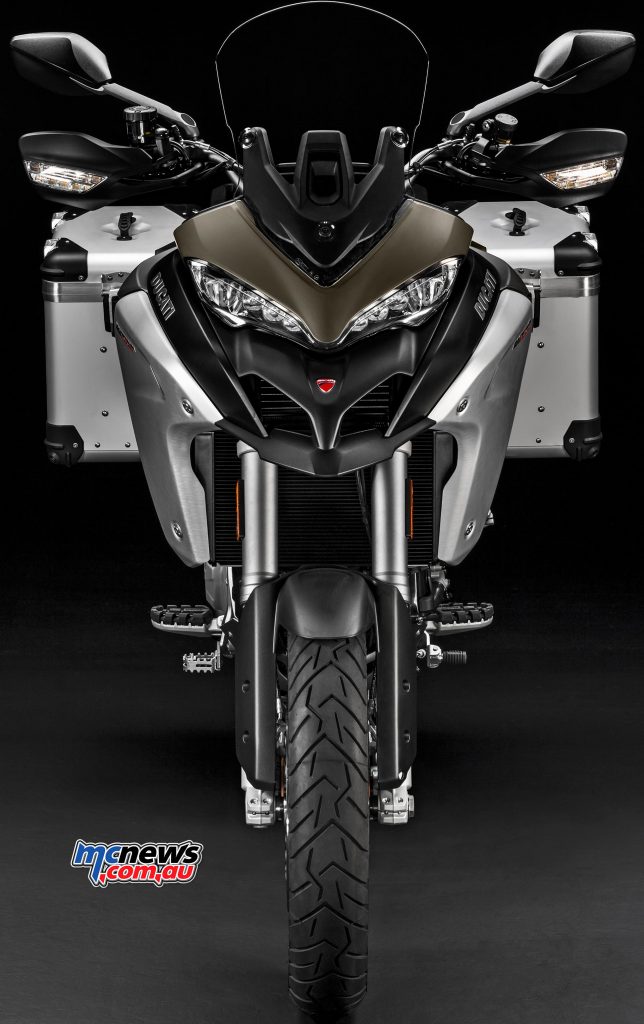
ABS can also be applied to the front wheel only, as is the case in Enduro Riding Mode, the aim being to allow rear wheel lock on the dirt. ABS can also be fully disabled from the instrument panel in any Riding Mode, and settings can be saved and recalled at the next Key-On.
The system integrates smoothly with the Ducati Riding Modes and has three available levels. Level 1 maximises off-road performance by disabling rear wheel lift detection and allowing the rear wheel to lock, with ABS being applied only at the front.
Level 2 ensures, in Sport mode, equilibrium between front and rear without rear wheel lift detection but with the Cornering function on and calibrated for sports-style riding. Level 3 allows, in Touring and Urban modes, optimisation of the combined braking action with rear wheel lift detection on and performance and with Cornering functionality on and calibrated for maximum safety.
The front braking system on the new Multistrada 1200 features monobloc radially-mounted Brembo 4-piston callipers with 32 mm diameter pistons and 2 pads, a radial master cylinder with adjustable lever, and dual 320 mm discs. At the rear, there is a single 265 mm diameter disc gripped by a floating calliper, again from Brembo. These components ensure top braking performance, a standard Ducati feature.
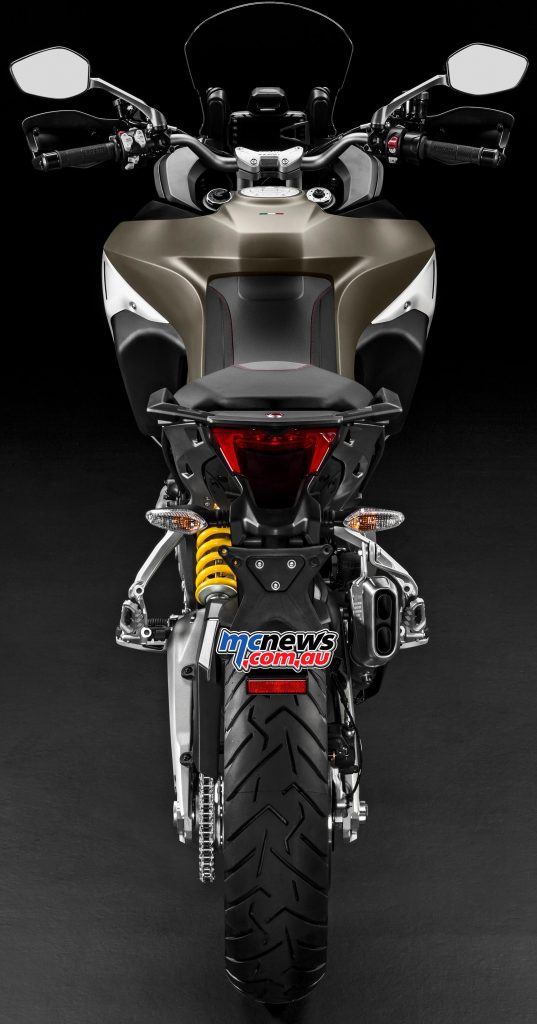
Vehicle Hold Control (VHC)
On the Multistrada 1200 the ABS features the Vehicle Hold Control (VHC) system. When activated, the latter holds the vehicle steady by applying rear wheel braking (if unused automatic deactivation occurs after 9 seconds). This provides riders with easier restarts; this is because it modulates brake pressure during starts, leaving the rider free to focus on throttle and clutch control.
The function is activated when, with the bike at standstill and the kickstand up, the rider applies high pressure on the front or rear brake levers. On activation the system calculates and applies, according to vehicle status, pressure on the rear brake system by acting on the pump and the ABS control unit valves.
This system can be activated at all ABS levels, except for when the ABS is switched off. VHC activation is indicated by a warning light. The same warning light starts flashing when the system is about to release pressure on the rear wheel and cease holding the vehicle: pressure reduction is gradual.
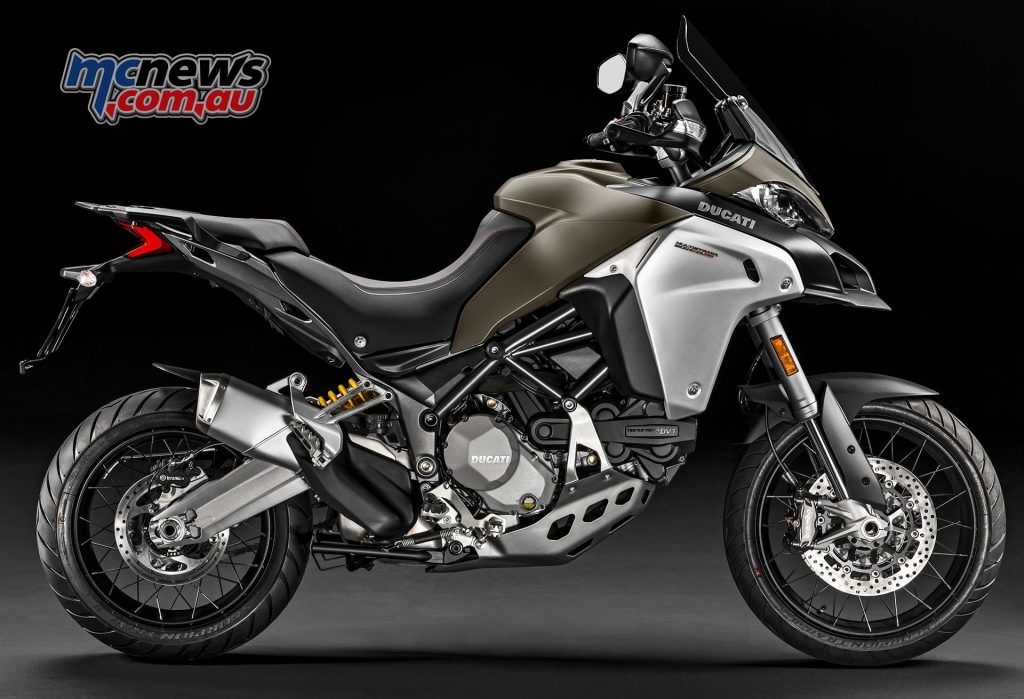
Instrument panel and lighting
The dashboard consists of a large full colour 5” TFT display. It provides info on speed, rpm, selected gear, total mileage, trip1 and trip2, engine coolant temperature, fuel gauge and a clock. Other information shown includes the selected Riding Mode, miles remaining, current fuel consumption, average fuel consumption, average speed, air temperature, travelling time and an icy road surface warning.
Each Riding Mode displays information differently. Enduro Riding Mode, moreover, displays the Trip Master function, which allows the progress of a specific trip to be adjusted (reduced or increased).
At a standstill it is possible to gain access, via the left handlebar switchgear, to a settings menu which enables and adjusts various functions such as DTC and DWC personalisation and the 3-level Cornering ABS function. Suspension can also be adjusted through the settings menu.
It is also possible, either at a standstill or on the move, to select the Riding Mode (Sport, Touring, Urban or Enduro) and load settings to correspond with the current riding configuration: rider only, rider with luggage, rider with passenger or rider with passenger and luggage.
The Multistrada 1200 Enduro features a full LED headlight with Ducati Cornering Lights (DCL) functionality, which activates in curves to give optimal illumination of the road surface. Once again, it is the Bosch IMU inertial platform that makes this new function possible.
Another option designed to enhance lighting efficiency consists of a pair of supplementary headlights: controlled via a dedicated key on the left switchgear; these provide excellent peripheral lighting. The motorcycle also features hazard lights, activated simply by pressing a dedicated button.
Other options include heated grips that, when installed, are controlled by a dedicated button on the right switchgear.
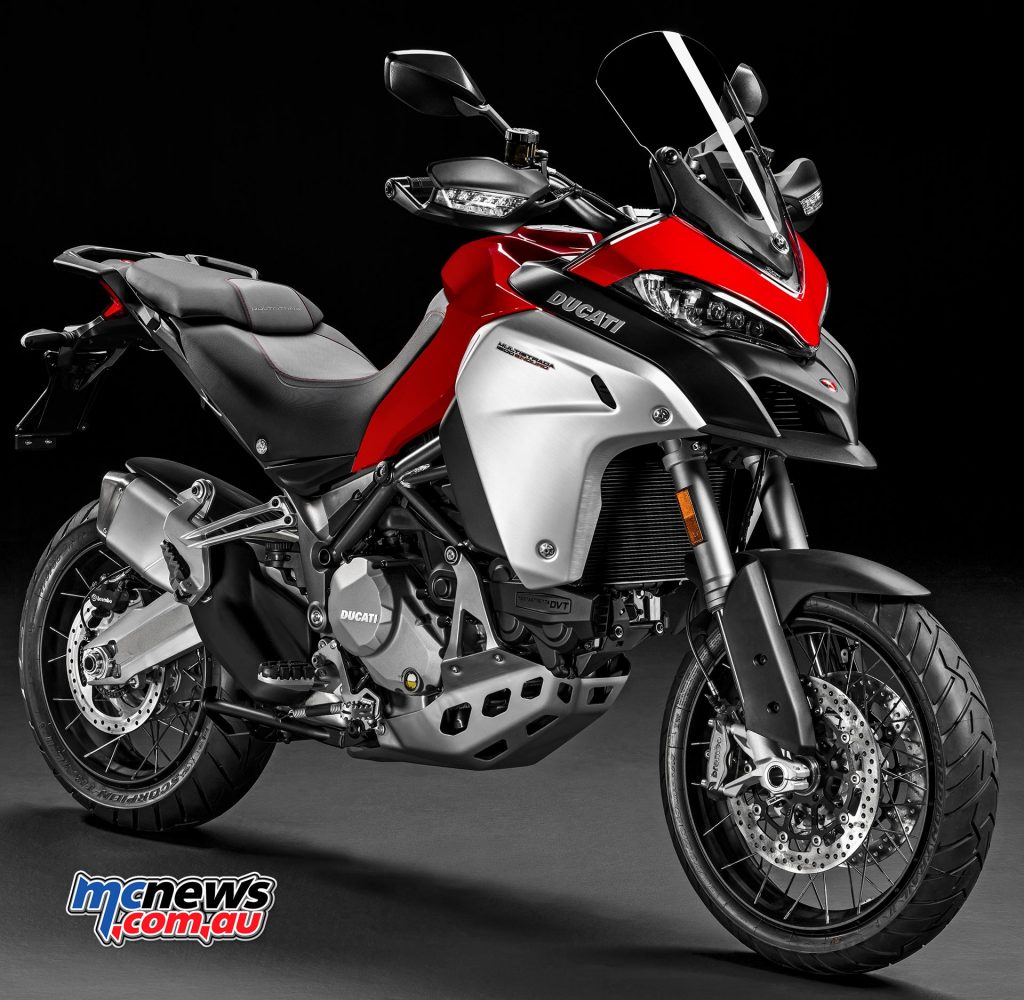
Hands Free Ignition
The Multistrada 1200 Enduro can be started without inserting a mechanical key, if its electronic key is within a 2 metre radius of the bike. The system automatically reads the key’s code, even if it is never removed from the rider’s pocket. Pressing the “on” button powers-up the bike, activates the display, and allows the engine to be started.
The electronic key also includes a mechanical “flip” key for seat and filler cap removal. Furthermore, the Multistrada 1200 Enduro features an electrical steering lock actuator: when the bike is parked. The steering lock can be engaged with the push of a button, and is automatically released when the bike is next turned on.
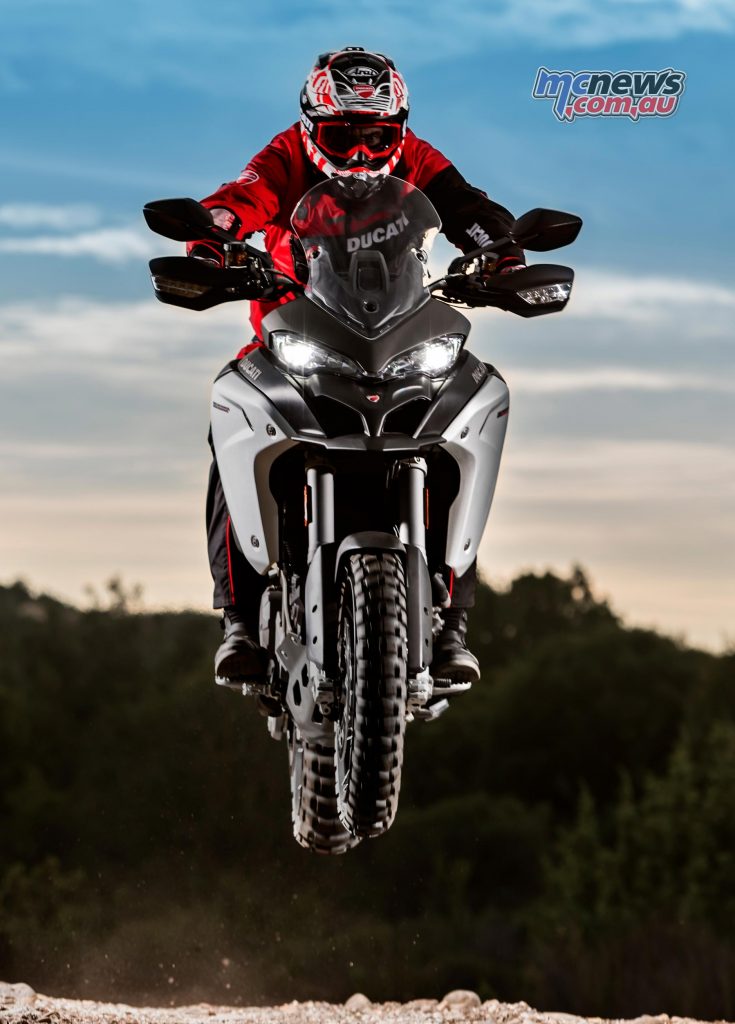
Chassis
The new Multistrada 1200 Enduro mounts components that, in terms of technological content and performance, are nothing less than state-of-the-art. Key chassis parameters such as vehicle wheelbase, swingarm length and steering geometry (trail and offset) have been defined by seeking out the best compromise between off-road riding, handling and high-speed stability.
The Multistrada 1200 Enduro has a solid frontal Trellis frame with large-diameter, low-thickness tubing while the two lateral sub-frames are closed off by a rear load-bearing, techno-polymer, fibreglass element to maximise torsional rigidity.
Compared to the Multistrada 1200, the minimum above-ground height of the Enduro version has been raised by 31 mm to 205 mm, an essential advantage when heading off-road.
The double-sided swingarm, longer than the single-sided one on the Multistrada 1200, is made of shell-cast aluminium. Specially designed for off-road use, this tough swingarm combines limited weight with an excellent ability to absorb the punishment meted out by off-road riding
The new Multistrada 1200 Enduro features a Sachs steering damper that enhances control and rider confidence in extreme situations, allowing the rider to reach levels of performance previously unattainable in the large displacement travel enduro segment.
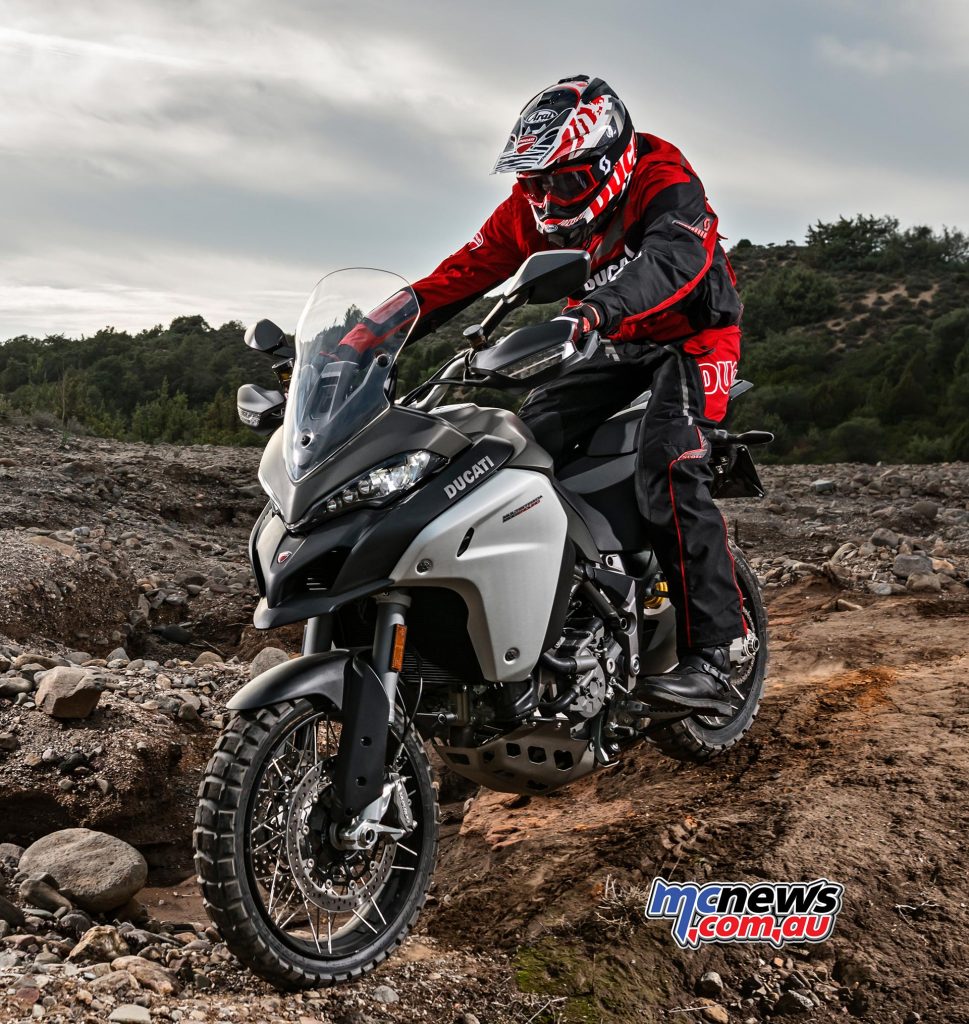
Suspension
The Multistrada 1200 Enduro features an upside-down 48mm fork with sleeves in characteristic ceramic grey and an extended wheel hub, as on off-road bikes. The rear wheel, instead, mounts a Sachs shock absorber.
Controlled by the Ducati Skyhook Suspension (DSS) system, both front and rear suspension are new in terms of both their mechanics and the software, providing automatic adjustment – integrated into the Riding Modes – of both rebound and compression damping and spring pre-load. The set-up can also be customised via the on-board computer.
Specially designed for the Multistrada 1200 Enduro, the suspension ensures 200mm of wheel travel at both the front and the rear and features a semi-active setting to optimise off-road performance.
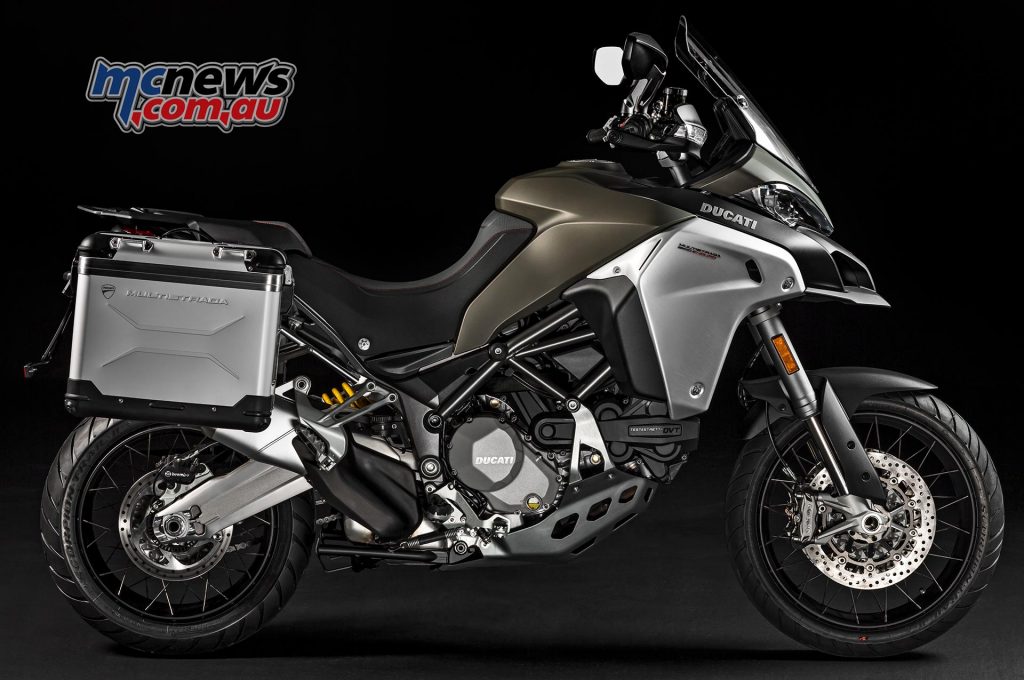
Tyres and wheels
The Multistrada 1200 Enduro is equipped with Pirelli Scorpiont Trail II tyres, 120/70 R19 at the front and 170/60 R17 at the rear. This tyre successfully merges two very different fields of use: off-road racetracks and road riding. Designed for even the most demanding motorcyclists, its advantages include excellent mileage, consistent performance throughout its lifespan and first-rate wet weather handling.
The Multistrada 1200 Enduro features tubeless, spoked wheels with aluminium rims, 40 cross-mounted spokes and gravity-cast hubs. The measurements are 3.00 x 19in at the front and 4.50 x 17in at the rear.























